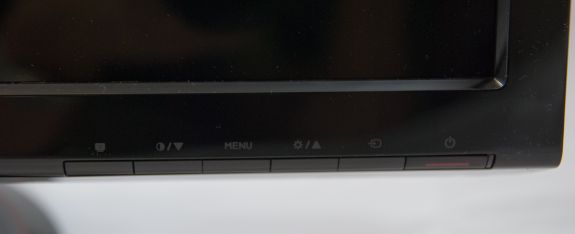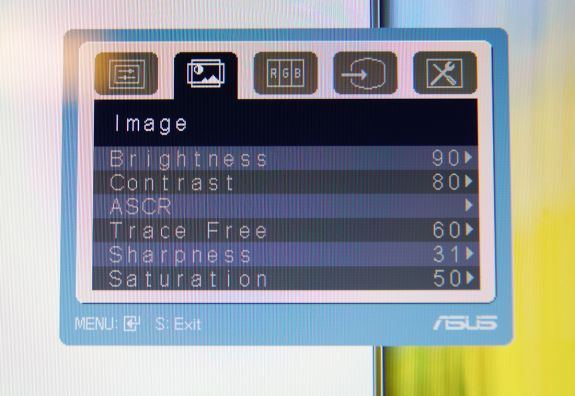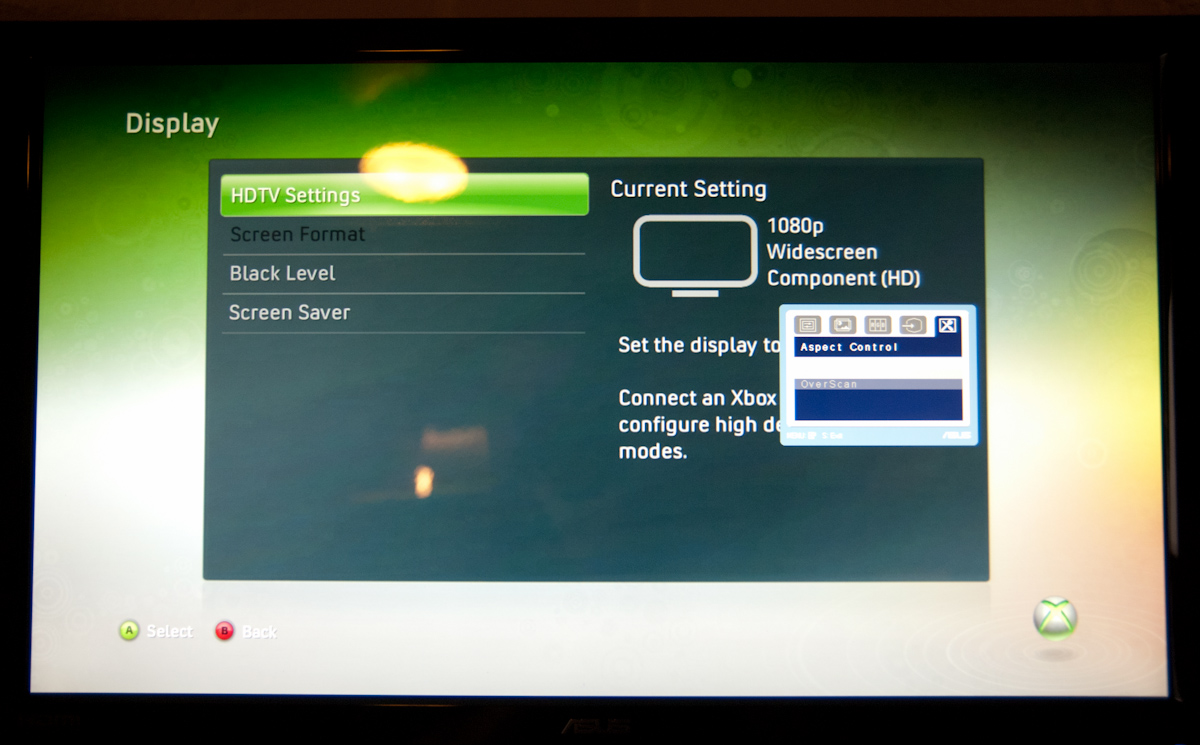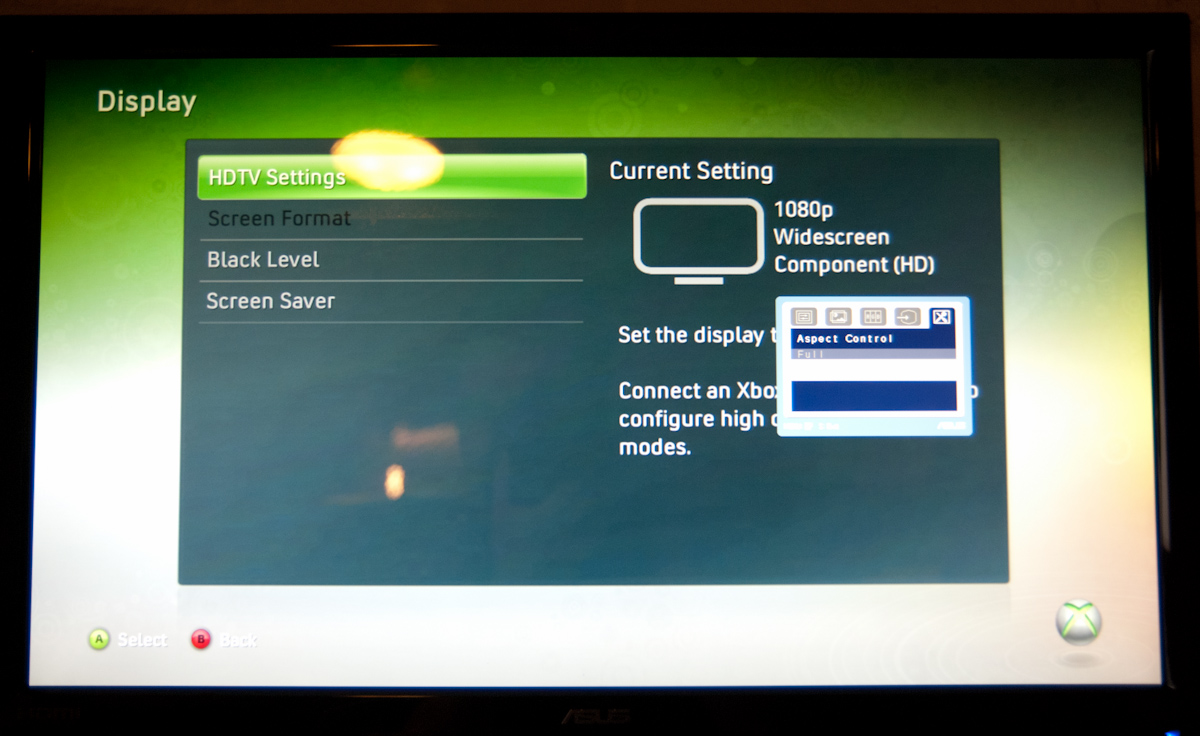ASUS VG236H 23-inch 3D Display Review: 120Hz is the Future
by Brian Klug on August 7, 2010 2:48 AM ESTOSD Controls
The front of the display is glossy, but tasteful. There’s the ASUS logo front and center, a subtle HDMI logo silkscreened in the bottom left, and on the bottom right are the OSD control buttons. To the right of the rightmost button is a blue power LED.
I guess these buttons are my second and last major complaint about the VG236H. There are 6 buttons, and while they work just fine and the control schema itself is straightforward, the problem is just how hard to see they are. The symbols are screened onto the plastic, and are just too hard to see.
The other problem is that there aren’t any raised edges or bits on them, so it’s hard to know when you’re actually pressing the center of a button. Most of the time, I just counted gaps to tell which button I was on. The power button has a small red line which differentiates it, but the rest are all the same and are just a bit difficult to use. There’s also a bit of flex in the whole display arm when pressing these buttons.
There’s a dedicated source button, menu button, and ‘splendid’ display mode button which cycles through five presets. The up and down buttons change brightness and contrast when the menu isn’t up. Tap down, and you can change contrast. Tap up, and you can change brightness. After tapping and entering respective modes, you can adjust in both directions.
I figure we should talk about the OSD controls here, which are actually very good. ASUS exposes different settings in the image tab depending on which spelendid mode you’re using. Under Standard, you’ll only be given brightness, contrast, and trace free - which lets you directly control LCD Overdrive. You can change ‘Trace Free’ in increments of 20, from 0 to 100.
Change modes to ‘Game’, and you can change brightness, contrast, ASCR (dynamic contrast), trace free, sharpness, and saturation. In fact, all of the modes except Standard seem to expose all the settings, which is interesting.
When you’re in 3D mode, the OSD also locks down into predefined settings for optimal 3D quality. In fact, all you’re left able to control is contrast. I can understand this - when doing things in 3D, you’re going to want all the brightness the panel can deliver, and probably the most ‘Trace Free’ the display can offer.
ASUS also thankfully provides a variety of OSD aspect ratio controls. You can select from full, 4:3, and overscan. There’s no 1:1 option, but what content seriously isn’t 1080P these days anyways? Full and 4:3 are self explanatory - Full is basically stretch, while 4:3 leaves you with black bars.
Overscan is a bit different, and I’m surprised ASUS included it, but props for doing so. I’d say that overscan is still a misunderstood beast for a lot of the population, but it’s simple - it’s extra image around the viewable image which gets cropped out. Back in the days of CRT TVs (seriously, can you still find a CRT TV at a store anymore?), image placement wasn’t perfect. To ensure uniformity, there was a safe area for content and important information, and a border that would get cut off. If you’ve ever done layout for publishing, think about the bleed area used for trimming, and you’ll get the picture exactly.
You can see the difference between the xbox dashboard with overscan on and off here. Basically, putting the monitor in overscan mode is what you’ll want to do, as you get close to 1:1 reproduction with no cropping. It’s awesome that ASUS included this, even a number of high end TVs have ambiguous or no overscan control, which is annoying.
There’s also our complete OSD tour in the gallery below:
Viewing Angles
Viewing angles on the VG236H are what you’d expect from a TN panel. There isn’t very much contrast or color distortion viewing the display at even extreme horizontal angles, it’s vertical angles that are sensitive to viewing angle. Check out our viewing angle gallery below:
ASUS advertises 170 degrees of viewing angle in the horizontal plane, and 160 degrees in the vertical with a 10:1 contrast ratio. I’d say the vertical angle you get isn’t quite as advertised, but honestly if you’re viewing the monitor from so far down below that this is noticeable, you’re probably doing something wrong and will complain more about damage to your spine than how colors look funny.
I’d say viewing angles overall are pretty standard on the VG236H.


























121 Comments
View All Comments
DarkUltra - Thursday, August 19, 2010 - link
PS I use http://www.lagom.nl/lcd-test/black.php and http://www.lagom.nl/lcd-test/white.php and a few new 23" 1080p lcd we have at work are really bad at these tests. My dads benq g2400w is good, so TN can perform and I hope the LG W2363D is similar.AllenP - Wednesday, September 8, 2010 - link
Hey, I had a question about this statement:"It just so happens that it’s pulling one frame behind, which on average worked out to a lag of 1.9 ms."
Sorry, I don't quite understand where those numbers are coming from... what do you mean by "one frame"? One frame is 8.3ms at 120 Hz or 16.7ms at 60Hz... To be honest, I guess it really doesn't matter: the graphics card ends up being the one that decides how much latency exists between outputs, especially when it's working with two signals at different refresh rates.
I would recommend using a more simple method of testing that always tries to get the exact same frame, refresh rate, and resolution to both monitors after it leaves the graphics card though one DVI-I port... This will eliminate all the confusion about how much latency the graphics card has when reading from the frame buffer to two different DVI ports. You'll need a really good CRT for that kind of test (one that can support like 1080P+ at 120Hz+), but I'm sure they exist. This way you can just split the DVI-I to a DVI and VGA using a passive component like this: http://sewelldirect.com/gefen-dvi-dvi-and-vga.asp -- Then the only element introducing discrepancies would be the DAC inside your graphics card that is used on the DVI-I (which I would assume is happens /after/ the frame is read from the frame buffer with most graphics cards that support this type of simultaneous output).
v12v12 - Tuesday, September 14, 2010 - link
You know when I 1st read the review of this, I thought to myself; hrmmm could I too be "wrong" about this whole 3D-imagery non-nonse... Am I missing out on something really good, bc I'm bias towards CRTs? Thankfully the answer is NO! I'm not missing anything lol!I love my habit of always reading through the comments section; you REALLY can segregate the meat from the fat when you go through pages of comments. Comments with BRUTAL honesty and usually spot on; what you don't find in Klug's fanboy-hyped review. Seriously I started questioning my judgment(s) about 3D, 120hz, and (omg) TN-panels, LMFAO! TN—really (?!), for all this money and supposed advancement?!
__Thanks to the numerous comments about these and many more "overlooked" features/technological implements, I've slammed the gavel on this ridiculous review; GUILTY! This monitor is nothing more than old technology, souped-up with some racing stripe, coffee-can exhaust like "advances," repackaged for the sheepish plebs. Yep I said Plebs; the sheep that will do EXACTLY what the OP has suggested; go out and get this monitor right now! ORLY? Then you read the comments and see all the major flaws of this ricer "technology..." I've been saying this for YEARS when I saw LCDs starting to take a market foot-hold; high-tech MARKETING is selling low-end technology as STANDARD FOR US ALL! WTF?
Haha, I love having a marketing background; makes seeing all these smoke and mirror, Vegas light and dazzle shows so much easier... But nope, plenty of sheep out there that will be saving up or going out right now to support this con-artist marketing of low-tech "advancement(s)," which hurts the real technological enthusiast or just simply someone that knows the TRUTH about how most folks are being duped on the daily, which sets market precedent for EVERYONE to get with, or pay much more for what we all should demand!
TN? Glossy? 1/2 arse 3D? No game port? Lack of real lag testing? 16:9???! PRICE? Yeah MARKETING folks...
I'll PASS!
Zoeff - Friday, September 17, 2010 - link
Brian, what would be your recommended settings for this monitor when using it for both playing games and some photo editing?Thanks!
Deusfaux - Monday, October 4, 2010 - link
a 16:10 monitor won't allow you to better see/hunt down enemies in a videogame, as you imply, with it's increased height.Almost all widescreen compatible games are Horizontal+, and the vertical FOV is constant. You're actually seeing less with a narrower 16:10 display than a wider 16:9 one.
NiteTortoise - Wednesday, October 6, 2010 - link
Hey Brian Klug -I think you have the wrong model # for the display without the glasses. You list it as VG246HE, but its actually VG236HE per Asus's website: http://usa.asus.com/product.aspx?P_ID=RiEoeerrSbel...
I spent a couple hours trying to find the display without the glasses, and I'm sure others have been in the same situation!
Thanks!
snuuggles - Monday, November 22, 2010 - link
I've been gaming on an older 32" 720p lcd tv for about 3 years. In a pinch I can use it as a monitor for work or browsing email, but of course the resolution is a bit low for that stuff...I'd really like to replace it with a higher resolution monitor, but I don't want to go too much smaller, and I'm *very* sensitive to input lag/low fps/ghosting/motion issues.
Basically for gaming, the things that matter (to me) are:
- input lag
- size of screen
- native resolution that is a good comprimise between sharp/useful-for-work and not-a-frame-rate-killer (hellooooo 1080p, booooo 2560x1600)
- minimal ghosting/trailing/whatever motion artifacts
not important:
- viewing angle (it's just me!)
- color reproduction (I don't edit photos)
- energy consumption (unless it starts costing dollars per day, PC gaming is just going to cost real money, and my electric bill is just not an issue compared to all the other costs, even if it *doubles*)
Seems like a large-format (27"+), 1080p TN+Film 120hz monitor for 500-600 would be something I should expect to be able to buy. Why is there no such thing? For *any* price?!?!
Can anyone say *for sure* that any of the new 3d TVs actually accept 120hz input. In other words, I know at least some (most? al?) of them use a funny "frame packing" method to get the two frames to the tv, basically using the same 60hz input with a funny resolution that the tv then just splits and displays one after the other. Are there *any* 3d tvs that actually accept a true 120hz 1080p input that I could use as a large monitor? Anything in the next year?
Should I just say screw it and get the zr30w and game at 1280x800 and work at full rez? There's no way I'm dropping 600 every year just to have a video card that can play the latest games at full rez.
Seems really really lame that the only two 27" 120hz monitors I can find listed anywhere on google have no release date. What is going on, should I just wait, or is there some reason that the things I care about just don't seem to be something people want to deliver a product for?
snuuggles - Monday, December 6, 2010 - link
Anyone (Brian) looking at this thread anymore? I know I'm basically posing on a dead article, but there's no 'display' section of the forums, and I haven't seen the answer to my questions anywhere (here, TFT reviews, avs forums)!My questions consolidated for convenience:
- When are larger-format (27"+) 120hz input monitors coming out. Is there some reason they aren't out already?
- assuming the above is going to take a while (6+ months), are there any TVs out there now that will take a 120hz input and display it at 120hz.
- Assuming there are no tvs currently available that can do that, can anyone say with confidence that 2011 will bring some (given that they'll all have HDMI 1.4 and that supposedly would support 1080p@120hz input). Or will they continue to insist on the ridiculous "frame packing" bs, and not even allow 120hz input.
It just seems strange that I can't get what I want which is a large (27-42"), low lag, 120hz input display at 1080p.
Thanks again! Sorry if I'm posting in an inappropriate place.
Onslaught2k3 - Saturday, December 4, 2010 - link
Every single display won't have everything you need. People bashing 120hz calling it a gimmick are just silly. Gamers spend hundreds finding the best mouse around that'll move at 5000+ DPI. After buying this montior, going over 2500 DPI on a laser gaming-grade mouse is unnecessary because the 120hz display effectively doubles the DPI @ 60Hz. You can use a cheaper mouse with this monitor and save money on what you would otherwise be spending on a freaking peripheral! That on its own is pretty good. I have a Samsung T260 paired with this monitor (I've paid MORE for the T260 back in may of 2008 than I did for the VG236HE - the one without the nvidia 3d kit since I use a AMD graphics card) and the difference is plain stunning. Since I focus what's on screen and not on my reflection I find that the glossy screen resembles a CRT with regards to colour reproduction. But as people have said here I know for a fact that CRTs are far better in almost every regard to an LCD picture and colour-wise. My next monitor purchase will most likely be a 120hz IPS panel that is around 27". This probably won't happen for another 3-5 years.MLSCrow - Monday, December 6, 2010 - link
The title of the Article is, "...120Hz is the future", but I think what you really should say is, "...240Hz is the future".Reason(s) being;
In the introduction of your article, you wrote, "I spent the first half hour seriously just dragging windows back and forth across the desktop - from a 120Hz display to a 60Hz, stunned at how smooth and different 120Hz was. Yeah, it’s that different."
With that said, I agree, 120Hz is amazing in comparison to 60Hz. I've been noticing the difference ever since I tried noticing the difference, back in the CRT days, however, once you activate 3D mode, you break that value in half for each eye. So, as you said, the 120Hz, becomes 60Hz per eye in 3D mode. However, in order to have that same smoothness that you saw 120Hz prior to 3D mode, during 3D mode, you would need a 240Hz display and considering that 240Hz 3D capable displays (120Hz per eye in 3D mode) are currently available, I'm sure you'd agree that it really is 240Hz that is the future.
Cheers.
-Fan since genesis.